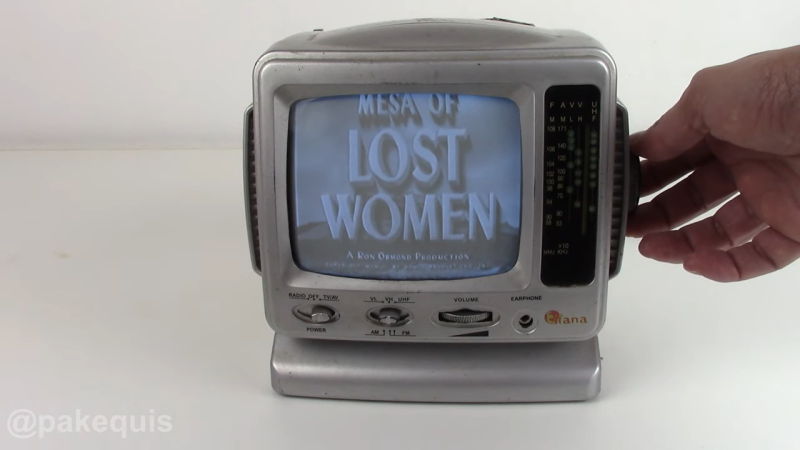If you’ve laid hands on a retro analog TV, have the restoration bug, and you plan to make the final project at least somewhat period-correct, you face a bit of a conundrum: what are you going to watch? Sure, you can serve up just about any content digitally these days, but some programs just don’t feel right on an old TV. And even if you do get suitably retro programming, streaming isn’t quite the same as the experience of tuning your way through the somewhat meager selections as we did back in the analog days.
But don’t worry — this Raspberry Pi TV simulator can make your streaming experience just like the analog TV experience of yore. It comes to us from [Rodrigo], who found a slightly abused 5″ black-and-white portable TV that was just right for the modification. The battery compartment underneath the set made the perfect place to mount a Pi, which takes care of streaming a variety of old movies and shorts. The position of the original tuning potentiometer is read by an Arduino, which tells the Pi which “channel” you’re currently tuned to.
Composite video is fed from the Pi’s output right into the TV’s video input, and the image quality is just about what you’d expect. But for our money, the thing that really sells this is the use of a relay to switch the TV’s tuner back into the circuit for a short bit between channel changes. This gives a realistic burst of static and snow, just like we endured in the old days. Hats off to [Rodrigo] for capturing everything that was awful about TV back in the day — Mesa of Lost Women, indeed! — but still managing to make it look good.
















impressive, managed to use a PI AND an Arduino
where’s the 555 timer though
Probably already part of the TV.
Nice, I stashed a couple of these TVs and I was thinking of doing something similar, and having them stream old serials, like Crash Corrigan’s Undersea Kingdom, and Zorro’s Fighting Legion etc.
Best emulation I’ve seen to date. Congratulations!
Dan, what’s with the ATSC tag? Absolutely no ATSC involved here.
Did he mean NTSC?
If you want to get even more realistic, use an RF modulator from an old video game console and mod the tuning knob so it goes in and out of tune of that one channel only by moving the actual tuner with a multi lobed cam. That’s how you can “find” channels all over the “spectrum” at various places and actually tune into them with all the ghosting and rolling and warbling rather than just snapping in and out.
I know it’s silly, but I want a color version to play retro pie on!
Why is that silly most of the games on retro pi were meant to be played on CRTs.
https://www.youtube.com/watch?v=t_iHiWyucck
Like this one?
That TV is an Algol Brionvega Algol 11 Mk IV that has a SCART socket on the back, and also an s-video in. Using them to watch digital TV it’s straightforward, and if you use one of those compact models with a SCART plug attached to the box you could use the rabbit ears for reception. A frien dof mide did this.
Using a Raspberry Pi is easy as finding a jack to SCART cable.
If you dont need audio… build a kogawa simple tv transmitter with parts you have right now and feed it composite out from the pi (https://www.youtube.com/watch?v=hziVoq2_BZU – bad audio sry). Im just realisting you might not have a pi right now…;p
On a Pi, it’s possible to disable the color bust signal in the config file.
That may give a better monochrome image quality. 🙂
Okay, it may sound like nitpicking, but Composite Video is often associated with CVBS (Color VBS).
CVBS may stand for Color/Video/Blanking/Sync, but also color video baseband signal.
Plain monochrome video is VBS, not Composite!
– It merely contains brightness and blank/sync.
Composite however is the result of Luma (Brightness) and Chroma (Color) signals combined, plus blank/sync.
That’s in contrast to S-Video or Chroma/Luma ports, where color information has its own cable/wire.
NTSC and PAL are color standards, super sets of the original RS170 (US, equals 630 x 480) and CCIR (EU, equals 768 x 572) standards, respectively.
Please note that TVs/video monitors used “lines” as a resolution.
Professional analogue monochrome systems had 800 lines and up! 😃
Anyway, long story short..
Please just remember that VBS without color exists.
It may have a different name in your language, also.
In German, it’s called “BAS”, for example.
Without colour, VBS is a high quality connection if done right.
Similar to what RGB is to the arcade scene..
This would be nice with an older, larger TV, just not a live chassis one! Maybe he could also hook the Pi to the net and stream videos from Internet Archive as needed.
i love this, i did something kind of similar a few years ago: a custom TV channel for my son
https://imgur.com/gallery/F2jKe
the schedule has changed a lot, but it still works great.
(all the computer pieces were in my garage, the only purchase was the cheapo transmitter)
Wow, great idea!
Put one of those multilayer LCD modules from a Tek scope and make a field sequential colour version.
I always wondered why someone didn’t try this with the TV80 back in the day but seems that the reason was
the required LCD module was patented and not easy to retrofit due to the specific phosphor blend used.
A modern day equivalent might be some layered shutter glasses with one polarizer removed from each and a specific
drive signal to make it do R/G/B filtering.
Reason this isn’t often used is that CRT displays this small aren’t typically available.
The patent of course has now long expired.
Nobody liked my solution either of 15 mono tubes tinted red, green, blue on a giant wheel…..